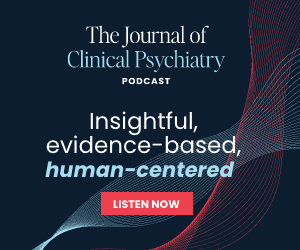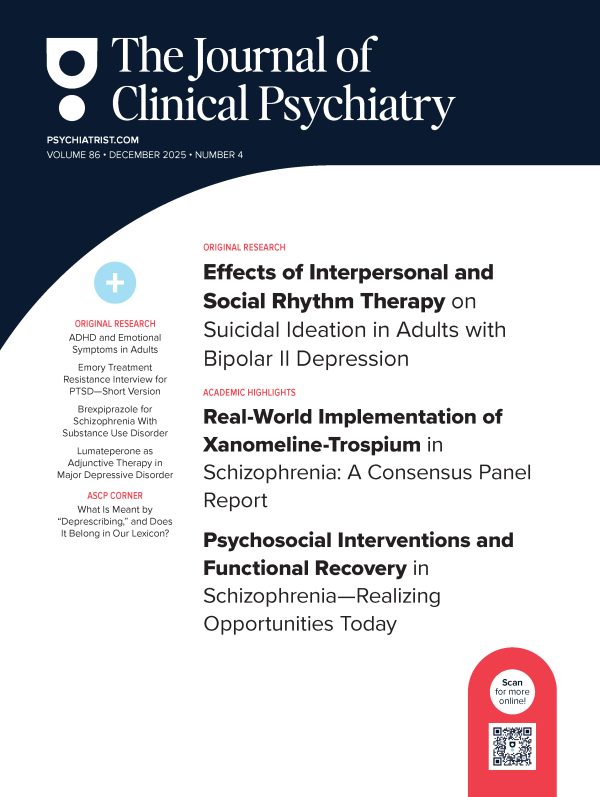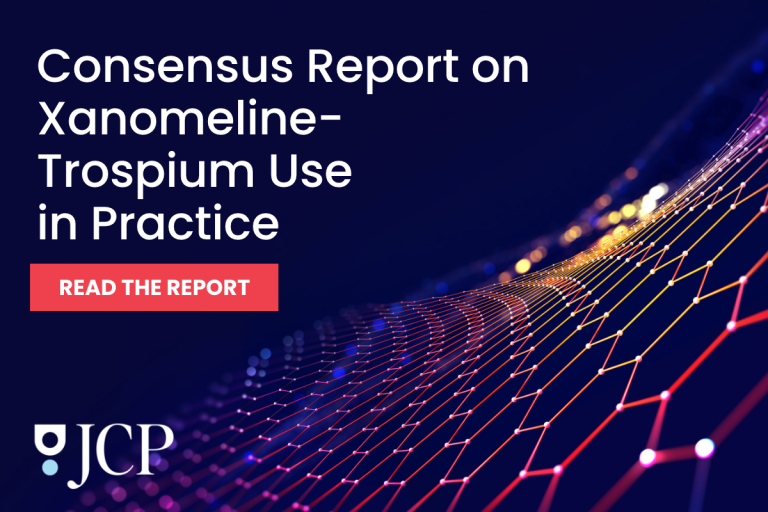Abstract
Objectives: Posttraumatic stress disorder is a significant public health concern in the US, with military veterans disproportionately affected. Although younger veterans exhibit a higher prevalence of posttraumatic stress disorder (PTSD) compared to their older counterparts, the mechanisms driving this age-related difference remain unclear. This study examined sociodemographic, trauma-specific, and psychosocial factors that may contribute to the elevated prevalence of PTSD in younger (age <50) vs older (age 50 and older) veterans.
Methods: Data were analyzed from the National Health and Resilience in Veterans Study, which surveyed a nationally representative sample of US military veterans (n=4,069).
Results: Younger veterans were 3 times more likely to screen positive for PTSD compared to older veterans (weighted 14.7% vs 4.9%, P<.001). Mediation analysis revealed that 90% of the association between younger age and PTSD was indirectly mediated by psychosocial and trauma-specific factors. Psychosocial difficulties contributed the most to accounting for this association (42.9%), followed by loneliness (23.6%), avoidance coping (9.7%), adverse childhood experiences (9.5%), and combat exposure severity (4.2%). Secondary analyses identified interpersonal relationship challenges, substance use and self-blame coping strategies, and childhood physical abuse as key mediators of this association.
Conclusion: Psychosocial and trauma-specific factors may mediate the link between younger age and higher rates of PTSD among US military veterans. These findings underscore the importance of targeted interventions designed to address psychosocial challenges, strengthen social connections, and promote adaptive coping strategies among younger veterans who are at risk for or currently living with PTSD.
J Clin Psychiatry 2025;86(4):25m15939
Author affiliations are listed at the end of this article.
Members Only Content
This full article is available exclusively to Professional tier members. Subscribe now to unlock the HTML version and gain unlimited access to our entire library plus all PDFs. If you’re already a subscriber, please log in below to continue reading.
References (83)

- Wisco BE, Nomamiukor FO, Marx BP, et al. Posttraumatic stress disorder in US Military Veterans: results from the 2019–2020 National Health and Resilience in Veterans Study. J Clin Psychiatry. 2022;83(2):21m14029. CrossRef
- Smith SM, Goldstein RB, Grant BF. The association between post-traumatic stress disorder and lifetime DSM-5 psychiatric disorders among veterans: data from the National Epidemiologic Survey on Alcohol and Related Conditions-III (NESARC-III). J Psychiatr Res. 2016;82:16–22. PubMed CrossRef
- Goldstein RB, Smith SM, Chou SP, et al. The epidemiology of DSM-5 posttraumatic stress disorder in the United States: results from the National Epidemiologic Survey on Alcohol and Related Conditions-III. Soc Psychiatry Psychiatr Epidemiol. 2016;51(8):1137–1148. PubMed CrossRef
- Pietrzak RH, Goldstein RB, Southwick SM, et al. Prevalence and Axis I comorbidity of full and partial posttraumatic stress disorder in the United States: results from Wave 2 of the National Epidemiologic Survey on Alcohol and Related Conditions. J Anxiety Disord. 2011;25(3):456–465. PubMed CrossRef
- Wisco BE, Marx BP, Wolf EJ, et al. Posttraumatic stress disorder in the US veteran population: results from the National Health and Resilience in Veterans Study. J Clin Psychiatry. 2014;75(12):1338–1346. PubMed CrossRef
- Wisco BE, Marx BP, Miller MW, et al. Probable posttraumatic stress disorder in the US veteran population According to DSM-5: results from the National Health and Resilience in Veterans Study. J Clin Psychiatry. 2016;77(11):1503–1510. PubMed CrossRef
- Fulton JJ, Calhoun PS, Wagner HR, et al. The prevalence of posttraumatic stress disorder in Operation Enduring Freedom/Operation Iraqi Freedom (OEF/OIF) Veterans: a meta-analysis. J Anxiety Disord. 2015;31:98–107. PubMed CrossRef
- Vespa JE. Those Who Served: America’s Veterans From World War II to the War on Terror. United States Census Bureau; 2020.
- Kilpatrick DG, Resnick HS, Milanak ME, et al. National estimates of exposure to traumatic events and PTSD prevalence using DSM-IV and DSM-5 Criteria. J Trauma Stress. 2013;26(5):537–547. PubMed CrossRef
- Roberts AL, Gilman SE, Breslau J, et al. Race/ethnic differences in exposure to traumatic events, development of post-traumatic stress disorder, and treatment seeking for post-traumatic stress disorder in the United States. Psychol Med. 2011;41(1):71–83. PubMed CrossRef
- Alegría M, Fortuna LR, Lin JY, et al. Prevalence, risk, and correlates of posttraumatic stress disorder across ethnic and racial minority groups in the United State. Med Care. 2013;51(12):1114–1123. PubMed
- McLaughlin KA, Alvarez K, Fillbrunn M, et al. Racial/ethnic variation in trauma related psychopathology in the United States: a population-based study. Psychol Med. 2019;49(13):2215–2226. PubMed CrossRef
- Felitti VJ, Anda RF, Nordenberg D, et al. Relationship of childhood abuse and household dysfunction to many of the leading causes of death in adults: the Adverse Childhood Experiences (ACE) Study. Am J Prev Med. 1998;14(4):245–258. PubMed CrossRef
- Anda RF, Felitti VJ, Bremner JD, et al. The enduring effects of abuse and related adverse experiences in childhood. A convergence of evidence from neurobiology and epidemiology. Eur Arch Psychiatry Clin Neurosci. 2006;256(3):174–186. PubMed CrossRef
- Blosnich JR, Dichter ME, Cerulli C, et al. Disparities in adverse childhood experiences among individuals with a history of military service. JAMA Psychiatry. 2014;71(9):1041–1048. PubMed CrossRef
- Woodruff T, Kelty R, Segal DR. Propensity to serve and motivation to enlist among American combat soldiers. Armed Forces Soc. 2006;32(3):353–366. CrossRef
- Ginexi EM, Miller AE, Tarver D. A qualitative evaluation of reasons for enlisting in the military: Interviews with new active duty recruits. Defense Manpower Data Center; 1994.
- Sadler AG, Booth BM, Mengeling MA, et al. Life span and repeated violence against women during military service: effects on health status and outpatient utilization. J Womens Health. 2004;13(7):799–811. PubMed CrossRef
- Giano Z, Wheeler DL, Hubach RD. The frequencies and disparities of adverse childhood experiences in the U.S. BMC Public Health. 2020;20(1):1327. PubMed CrossRef
- Xue C, Ge Y, Tang B, et al. A meta-analysis of risk factors for combat-related PTSD among military personnel and veterans. PLoS One. 2015;10(3):e0120270. PubMed CrossRef
- Na PJ, Schnurr PP, Pietrzak RH. Mental health of U.S. combat veterans by war era: results from the National Health and Resilience in Veterans Study. J Psychiatr Res. 2023;158:36–40. PubMed CrossRef
- Kelly UA, Skelton K, Patel M, et al. More than military sexual trauma: interpersonal violence, PTSD, and mental health in women veterans. Res Nurs Health. 2011;34(6):457–467. PubMed CrossRef
- Kimerling R, Street AE, Pavao J, et al. Military-related sexual trauma among Veterans Health Administration patients returning from Afghanistan and Iraq. Am J Public Health. 2010;100(8):1409–1412. PubMed CrossRef
- Klingensmith K, Tsai J, Mota N, et al. Military sexual trauma in US veterans: results from the National Health and Resilience in Veterans Study. J Clin Psychiatry. 2014;75(10):e1133–e1139. CrossRef
- Nichter B, Holliday R, Monteith LL, et al. Military sexual trauma in the United States: results from a population-based study. J Affect Disord. 2022;306:19–27. PubMed CrossRef
- Kessler RC, Sonnega A, Bromet E, et al. Posttraumatic stress disorder in the National Comorbidity Survey. Arch Gen Psychiatry. 1995;52(12):1048–1060. PubMed CrossRef
- Ozer EJ, Best SR, Lipsey TL, et al. Predictors of posttraumatic stress disorder and symptoms in adults: a meta-analysis. Psychol Bull. 2003;129(1):52–73. PubMed CrossRef
- Breslau N. The epidemiology of trauma, PTSD, and other posttrauma disorders. Trauma Violence Abuse. 2009;10(3):198–210. PubMed CrossRef
- Pietrzak RH, Goldstein MB, Malley JC, et al. Risk and protective factors associated with suicidal ideation in veterans of Operations Enduring Freedom and Iraqi Freedom. J Affect Disord. 2010;123(1-3):102–107. PubMed CrossRef
- Korem N, Ben-Zion Z, Spiller TR, et al. Correlates of avoidance coping in trauma exposed U.S. military veterans: results from the National Health and Resilience in Veterans Study. J Affect Disord. 2023;339:89–97. PubMed CrossRef
- Solomon Z, Horesh D, Ein-Dor T. The longitudinal course of posttraumatic stress disorder symptom clusters among war veterans. J Clin Psychiatry. 2009;70(6):837–843. PubMed CrossRef
- Solomon Z, Mikulincer M. Posttraumatic intrusion, avoidance, and social functioning: a 20-year longitudinal study. J Consult Clin Psychol. 2007;75(2):316–324. PubMed CrossRef
- Morina N. The role of experiential avoidance in psychological functioning after war-related stress in Kosovar civilians. J Nerv Ment Dis. 2007;195(8):697–700. PubMed CrossRef
- Marx BP, Sloan DM. Peritraumatic dissociation and experiential avoidance as predictors of posttraumatic stress symptomatology. Behav Res Ther. 2005;43(5):569–583. PubMed CrossRef
- Orcutt HK, Pickett SM, Pope EB. Experiential avoidance and forgiveness as mediators in the relation between traumatic interpersonal events and posttraumatic stress disorder symptoms. J Soc Clin Psychol. 2005;24(7):1003–1029. CrossRef
- Cohen S, Wills TA. Stress, social support, and the buffering hypothesis. Psychol Bull. 1985;98(2):310–357. PubMed CrossRef
- Brewin CR, Andrews B, Valentine JD. Meta-analysis of risk factors for posttraumatic stress disorder in trauma-exposed adults. J Consult Clin Psychol. 2000;68(5):748–766. PubMed CrossRef
- Zalta AK, Tirone V, Orlowska D, et al. Examining moderators of the relationship between social support and self-reported PTSD symptoms: a meta-analysis. Psychol Bull. 2021;147(1):33–54. PubMed CrossRef
- Pietrzak RH, Johnson DC, Goldstein MB, et al. Psychological resilience and postdeployment social support protect against traumatic stress and depressive symptoms in soldiers returning from Operations Enduring Freedom and Iraqi Freedom. Depress Anxiety. 2009;26(8):745–751. PubMed CrossRef
- Straus E, Norman SB, Tripp JC, et al. Behavioral epidemic of loneliness in older U.S. Military Veterans: results from the 2019-2020 National Health and Resilience in Veterans Study. Am J Geriatr Psychiatry. 2022;30(3):297–310. PubMed CrossRef
- Vogt D, Borowski S, Kumar SA, et al. Psychosocial well-being at the time of trauma exposure and risk of PTSD. JAMA Netw Open. 2024;7(10):e2440388. PubMed CrossRef
- Pietrzak RH, Levy BR, Tsai J, et al. Successful aging in older US veterans: results from the 2019-2020 National Health and Resilience in Veterans Study. Am J Geriatr Psychiatry. 2021;29(3):251–256. PubMed CrossRef
- United States Census Bureau. Current Population Survey, August 2019: Veteran Supplement Technical Documentation. United States Cencus Bureau; 2019.
- Weathers F, Blake D, Schnurr P, et al. The Life Events Checklist for DSM-5 (LEC-5). 6. Instrument available from the National Center for PTSD; 2021.
- Keane TM, Fairbank JA, Caddell JM, et al. Clinical evaluation of a measure to assess combat exposure. Psychol Assess J Consult Clin Psychol. 1989;1(1):53. CrossRef
- Kimerling R, Gima K, Smith MW, et al. The Veterans Health Administration and military sexual trauma. Am J Public Health. 2007;97(12):2160–2166. PubMed CrossRef
- Weathers F. The PTSD Checklist for DSM-5 (PCL-5). National Center for PTSD; 2013.
- Bovin MJ, Marx BP, Weathers FW, et al. Psychometric properties of the PTSD Checklist for Diagnostic and Statistical Manual of Mental Disorders-Fifth Edition (PCL-5) in veterans. Psychol Assess. 2016;28(11):1379–1391. PubMed CrossRef
- Campbell-Sills L, Stein MB. Psychometric analysis and refinement of the Connor Davidson Resilience Scale (CD-RISC): Validation of a 10-item measure of resilience. J Trauma Stress. 2007;20(6):1019–1028. PubMed CrossRef
- Schulenberg SE, Schnetzer LW, Buchanan EM. The Purpose in Life Test-Short Form: development and psychometric support. J Happiness Stud. 2011;12:861–876. CrossRef
- Carver CS. You want to measure coping but your protocol’s too long: consider the brief COPE. Int J Behav Med. 1997;4(1):92–100. PubMed CrossRef
- Wang AW-T, Cheng C-P, Chang C-S, et al. Does the factor structure of the brief COPE fit different types of traumatic events? Eur J Psychol Assess. 2016;34(3):162–173. CrossRef
- Sherbourne CD, Stewart AL. The MOS social support survey. Soc Sci Med. 1991;32(6):705–714. PubMed CrossRef
- Hughes ME, Waite LJ, Hawkley LC, et al. A short scale for measuring loneliness in large surveys: results from two population-based studies. Res Aging. 2004;26(6):655–672. PubMed CrossRef
- Marx B, Schnurr P, Lunney C, et al. The Brief Inventory of Psychosocial Functioning (B-IPF). Measurement Instrument; 2019. Accessed January 17, 2024. https://www.ptsd.va.gov/professional/assessment/functioning-other/ipf_psychosocial_function.asp.
- Galovski T, Lyons JA. Psychological sequelae of combat violence: a review of the impact of PTSD on the veteran’s family and possible interventions. Aggress Violent Behav. 2004;9(5):477–501. CrossRef
- Sayers SL, Farrow VA, Ross J, et al. Family problems among recently returned military veterans referred for a mental health evaluation. J Clin Psychiatry. 2009;70(2):163–170. PubMed CrossRef
- Monson CM, Taft CT, Fredman SJ. Military-related PTSD and intimate relationships: from description to theory-driven research and intervention development. Clin Psychol Rev. 2009;29(8):707–714. PubMed CrossRef
- MacDonald C, Chamberlain K, Long N, et al. Posttraumatic stress disorder and interpersonal functioning in Vietnam War veterans: a mediational model. J Trauma Stress. 1999;12(4):701–707. PubMed CrossRef
- Roberts WR, Penk WE, Gearing ML, et al. Interpersonal problems of Vietnam combat veterans with symptoms of posttraumatic stress disorder. J Abnorm Psychol. 1982;91(6):444–450. PubMed CrossRef
- Riggs DS, Byrne CA, Weathers FW, et al. The quality of the intimate relationships of male Vietnam veterans: problems associated with posttraumatic stress disorder. J Trauma Stress. 1998;11(1):87–101. PubMed CrossRef
- Carroll EM, Rueger DB, Foy DW, et al. Vietnam combat veterans with posttraumatic stress disorder: analysis of marital and cohabitating adjustment. J Abnorm Psychol. 1985;94(3):329–337. PubMed CrossRef
- Scoglio AAJ, Reilly ED, Girouard C, et al. Social functioning in individuals with post-traumatic stress disorder: a systematic review. Trauma Violence Abuse. 2022;23(2):356–371. PubMed CrossRef
- Shea MT, Vujanovic AA, Mansfield AK, et al. Posttraumatic stress disorder symptoms and functional impairment among OEF and OIF National Guard and Reserve veterans. J Trauma Stress. 2010;23(1):100–107. PubMed CrossRef
- Sippel LM, Roy AM, Southwick SM, et al. An examination of the roles of trauma exposure and posttraumatic stress disorder on emotion regulation strategies of Operation Iraqi Freedom, Operation Enduring Freedom, and Operation New Dawn veterans. Cogn Behav Ther. 2016;45(5):339–350. PubMed CrossRef
- Caska-Wallace CM, Smith TW, Renshaw KD, et al. Standardized assessment of relationship functioning in Iraq and Afghanistan veterans with PTSD. Mil Psychol. 2019;31(5):373–383. PubMed CrossRef
- Malaktaris AL, Buzzella BA, Siegel ME, et al. OEF/OIF/OND veterans seeking PTSD treatment: Perceptions of partner Involvement in trauma-focused treatment. Mil Med. 2019;184(3–4):E263–E270. PubMed CrossRef
- Schrader C, Ross A. A review of PTSD and current treatment strategies. Mo Med. 2021;118(6):546–551. PubMed
- Kelly MM, Reilly ED, Ameral V, et al. A randomized pilot study of acceptance and commitment therapy to improve social support for veterans with PTSD. J Clin Med. 2022;11(12):3482. PubMed CrossRef
- Liebman RE, Whitfield KM, Sijercic I, et al. Harnessing the healing power of relationships in trauma recovery: a systematic review of cognitive-behavioral conjoint therapy for PTSD. Curr Treat Options Psychiatry. 2020;7:203–220. CrossRef
- Ong AD, Cintron DW, Rottenberg J, et al. Loneliness trajectories in U.S. Military veterans: a 3-Year longitudinal study of risk and protective factors. J Gerontol B Psychol Sci Soc Sci. 2024;79(12):gbae171. PubMed CrossRef
- Fox R, McHugh Power J, Coogan AN, et al. Posttraumatic stress disorder and loneliness are associated over time: a longitudinal study on PTSD symptoms and loneliness, among older adults. Psychiatry Res. 2021;299:113846. PubMed CrossRef
- Hawkley LC, Cacioppo JT. Loneliness matters: a theoretical and empirical review of consequences and mechanisms. Ann Behav Med. 2010;40(2):218–227. PubMed CrossRef
- Mercier JM, Hosseiny F, Rodrigues S, et al. Peer support activities for veterans, serving members, and their families: results of a Scoping review. Int J Environ Res Public Health. 2023;20(4):3628. PubMed CrossRef
- Galovski TE, Street AE, Cooney CC, et al. Evaluating the impact of a peer support program on participants’ well-being: finding Belongingness through the women veterans network. Med Care. 2024;62(12 Suppl 1):S43–S49. PubMed CrossRef
- Eliacin J, Patterson SM, Mendez DM, et al. Findings from a peer-facilitated, social isolation intervention in the Veterans Health Administration healthcare system: a mixed-methods, pilot feasibility study. J Gen Intern Med. 2023;38(16):3460–3471. PubMed CrossRef
- Sullivan J, Gualtieri L, Campbell M, et al. VA Compassionate Contact Corps: a Phone-based intervention for Veterans Interested in Speaking with Peers. Innovation Aging. 2021;5(supplement_1):204–204. CrossRef
- Chirico F, Capitanelli I, Nowrouzi-Kia B, et al. Animal-assisted interventions and post-traumatic stress disorder of military workers and veterans: a systematic review. J Health Soc Sci. 2022;7(2):152–180.
- Leighton SC, Nieforth LO, O’Haire ME. Assistance dogs for military veterans with PTSD: a systematic review, meta-analysis, and meta-synthesis. PLoS One. 2022;17(9):e0274960. PubMed CrossRef
- Pietrzak RH, Harpaz-Rotem I, Southwick SM. Cognitive-behavioral coping strategies associated with combat-related PTSD in treatment-seeking OEF-OIF Veterans. Psychiatry Res. 2011;189(2):251–258. PubMed CrossRef
- Norman SB, Wilkins KC, Tapert SF, et al. A pilot study of seeking safety therapy with OEF/OIF veterans. J Psychoact Drugs. 2010;42(1):83–87. PubMed CrossRef
- Najavits LM, Weiss RD, Shaw SR, et al. “Seeking safety”: Outcome of a new cognitive-behavioral psychotherapy for women with posttraumatic stress disorder and substance dependence. J Trauma Stress. 1998;11(3):437–456. PubMed CrossRef
- Nilaweera D, Phyo AZZ, Teshale AB, et al. Lifetime posttraumatic stress disorder as a predictor of mortality: a systematic review and meta-analysis. BMC Psychiatry. 2023;23(1):229. PubMed CrossRef





